Load Effect Analysis Method of Cable-Stayed Bridge for Long-Span Track Based on Adaptive Filtering Method
Abstract
:1. Introduction
2. Project and Finite Element
2.1. Project Overview
2.2. Health Monitoring System
2.3. Finite Element Analysis
3. Load Effect Analysis Method
- According to the period T of the train crossing the bridge and the monitoring data acquisition frequency , the number of data samples required for analysis is determined.
- When the number of data samples reaches the minimum value and the median value of the data sample is obtained, where data sample f generally refers to structural stress, displacement, and cable force. If , the program preliminarily determines it as the train load effect data.
- Based on the finite element model, the calculated value under train load is obtained, and the limit value f is set, where is less than 1. The specific value is determined by the sample data, and the initial value of the sample is obtained. If ≥ , it is confirmed that these data samples are train load effect data.
- After the train load effect data are extracted, the initial sample value is subtracted to carry out initialization processing and remove the influence of temperature load.
4. Load Effect Separation Experiment
4.1. Analysis of Train Load Effect Based on Influence Line
4.2. Analysis of Temperature Load Effect Based on Correlation
5. Conclusions and Prospects
- The adaptive filtering load effect separation method proposed in this paper is both feasible and effective. Based on the characteristics of high frequency, large response, and periodicity of train load effect, a method for separating load effect is proposed. Through the signal separation of the composite structure response data obtained by the monitoring system, the respective effects of train load and temperature load at the same time are obtained, which provides scientific support for the state evaluation of the bridge and makes the evaluation results more accurate and reliable.
- The measured values of the structural influence line of the vertical displacement of the main beam, the longitudinal displacement of the main tower, and the stress index of the main beam under the action of train load are compared with the theoretical influence line obtained by simulation, based on the train load effect analysis method of the influence line. The normalized cross-correlation (NCC) of the two indexes was found to be 0.9457, 0.9531, 0.8873, 0.9098, and 0.9101. This demonstrated a very high degree of fit, indicating that no significant anomalies were found in the bridge and verifying the direct evaluation of the structural state of the line affected by the train load.
- The impact of ambient temperature on the cable-stayed bridge with a long-span track is profound, and there is a clear correlation between the response of each structural component. The temperature exhibits a strong negative correlation with the vertical displacement of the main beam, longitudinal displacement of the main tower (A0 side, P3 side, and P5 side), and Pearson correlation coefficient R < −0.7 of the stay cable. Conversely, the longitudinal displacement of the main tower (P2 side), roof stress in the main beam span, and floor stress in the main beam span exhibit a strong positive correlation coefficient R > 0.7. It has been demonstrated that the structural state can be evaluated indirectly by temperature load correlation.
- Comprehensive consideration of long-term effects: In addition to the load effect, the durability of the long-span track special cable-stayed bridge is also an important consideration. Therefore, in the future, a durability analysis will be carried out by monitoring the corrosion and fatigue of bridge materials to ensure the long-term safe operation of the bridge.
- Optimize the monitoring system: In the future, the combination of artificial intelligence and big data analysis technology with the establishment of a decision support system will facilitate more accurate real-time monitoring, analysis, and prediction of the load effect of long-span track special cable-stayed bridges. Through systematic data management and analysis, the efficiency and safety of bridge operation and maintenance will be enhanced.
Author Contributions
Funding
Data Availability Statement
Conflicts of Interest
References
- Li, X.; Luo, H.; Ding, P.; Chen, X.; Tan, S. Prediction Study on the Alignment of a Steel-Concrete Composite Beam Track Cable-Stayed Bridge. Buildings 2023, 13, 882. [Google Scholar] [CrossRef]
- Tan, H.; Qian, D.; Xu, Y.; Yuan, M.; Zhao, H. Analysis of Vertical Temperature Gradients and Their Effects on Hybrid Girder Cable-Stayed Bridges. Sustainability 2023, 1053, 1013. [Google Scholar] [CrossRef]
- Tan, D.-M.; Guo, T.; Gan, Q.-L. Separation of Temperature Effect in Monitored Deflection of Bridges Based on VMD-SVD. Bridge Constr. 2023, 53, 87–94. [Google Scholar]
- Wang, L.-B.; Wang, Q.-L.; Zhu, Z.; Zhao, Y. Current Status and Prospects of Research on Bridge Health Monitoring Technology. Zhongguo Gonglu Xuebao/China J. Highw. Transp. 2021, 34, 25–45. [Google Scholar]
- Fang, C.; Xu, Y.L.; Hu, R.; Huang, Z. A web-based and design-oriented structural health evaluation system for long-span bridges with structural health monitoring system. Struct. Control Health Monit. 2021, 29, e2879. [Google Scholar] [CrossRef]
- Kaloop, M.R.; Eldiasty, M.; Hu, J.W. Safety and reliability evaluations of bridge behaviors under ambient truck loads through structural health monitoring and identification model approaches. Measurement 2022, 187, 110234. [Google Scholar] [CrossRef]
- Chen, C.; Wang, Y.; Kaloop, M.R.; Wang, T.; Ma, J. Continuous Box-Girder Bridge Condition Assessment Based on Structural Health Monitoring System: A Case Study. In Proceedings of the 2020 International Conference on Intelligent Transportation, Big Data & Smart City (ICITBS), Vientiane, Laos, 11–12 January 2020; pp. 734–740. [Google Scholar]
- Li, X.Y.; Guan, Y.H.; Law, S.S.; Zhao, W. Monitoring abnormal vibration and structural health conditions of an in-service structure from its SHM data. J. Sound Vib. 2022, 537, 117185. [Google Scholar] [CrossRef]
- Svendsen, B.T.; Frøseth, G.T.; Øiseth, O.; Rønnquist, A. A data-based structural health monitoring approach for damage detection in steel bridges using experimental data. J. Civ. Struct. Health Monit. 2022, 12, 101–115. [Google Scholar] [CrossRef]
- Hanwen, J.; Yang, D.; Aiqun, L. Correlation model of deflection-temperature-vehicle load monitoring data for bridge structures. J. Vib. Shock 2023, 42, 79–89. [Google Scholar]
- Li, X.; Gao, M.; Zhou, J.; Chen, X.; Tan, S. Permanent deformation limits of long-span track cable-stayed bridges based on service performance analysis. Sage J. 2021, 40, 1215–1226. [Google Scholar] [CrossRef]
- Zhou, C.; Butala, M.D.; Xu, Y.; Demartino, C.; Spencer, B.F. FE-based bridge weigh-in-motion based on an adaptive augmented Kalman filter. Mech. Syst. Signal Process. 2024, 218, 111530. [Google Scholar] [CrossRef]
- Singh, P.; Bana, D.; Sadhu, A. Improved bridge modal identification from vibration measurements using a hybrid empirical Fourier decomposition. J. Sound Vib. 2024, 590, 118598. [Google Scholar] [CrossRef]
- Dan, D.; Zeng, G.; Pan, R.; Yin, P. Block-wise recursive sliding variational mode decomposition method and its application on online separating of bridge vehicle-induced strain monitoring signals. Mech. Syst. Signal Process. 2023, 198, 110389. [Google Scholar] [CrossRef]
- Hielscher, T.; Khalil, S.; Virgona, N.; Hadigheh, S.A. A neural network based digital twin model for the structural health monitoring of reinforced concrete bridges. Structures 2023, 57, 105248. [Google Scholar] [CrossRef]
- Liu, X.; Yang, J.; Zhuo, W.; Lin, K.; Lin, Y. Real-time identification of time-varying cable force for cable-stayed bridges based on vibration monitoring. Measurement 2024, 231, 114590. [Google Scholar] [CrossRef]
- Xu, X.; Shi, C.; Ren, Y.; Fan, Z.; Guo, Z.; Zeng, X.; Jin, Y.; Huang, Q. Probabilistic anomaly detection considering multi-level uncertainties for cable-stayed bridges. Structures 2023, 58, 105448. [Google Scholar] [CrossRef]
- Azhar, A.S.; Kudus, S.A.; Jamadin, A.; Mustaffa, N.K.; Sugiura, K. Recent vibration-based structural health monitoring on steel bridges: Systematic literature review. Ain Shams Eng. J. 2024, 15, 102501. [Google Scholar] [CrossRef]
- Fang, F.; Lv, K.; Qiu, L. Design of GMM Damage Alarm Software Based on Embedded Structural Health Monitoring System. Trans. Nanjing Univ. Aeronaut. Andastronautics 2023, 40, 62–68. [Google Scholar]
- Yi, T.H.; Zheng, X.; Yang, D.H.; Li, H.N. Lightweight design method for structural health monitoring system of short-and medium-span bridges. J. Vib. Eng. 2023, 36, 458–466. [Google Scholar]
- Yu, J.; Peng, Z.; Meng, X.; Xie, Y. GNSS-based Rea-time Vibration Monitoring and Dynamic Response Analysis of a Long-span SuspensionBridge under an Extreme Typhoon Event. China J. Highw. Transp. 2024, 1–14. Available online: http://kns.cnki.net/kcms/detail/61.1313.U.20240222.1338.002.html (accessed on 6 August 2024).
- Xiaopeng, L.Z.F. Study of Degradation Effects of Perforation and Welding on Fatigue Performance of Steel Deck. Bridge Constr. 2020, 50, 8–13. [Google Scholar]
- Miao, P.; Yokota, H.; Zhang, Y. Deterioration prediction of existing concrete bridges using a LSTM recurrent neural network. Struct. Infrastruct. Eng. 2023, 19, 475–489. [Google Scholar] [CrossRef]
- Tang, L.; Wu, T.; Mao, R.; Zhou, Z. Curvature Influence Line Area Difference Method for Damage Location of Bridge Structures. Yingyong Jichu Yu Gongcheng Kexue Xuebao/J. Basic Sci. Eng. 2022, 30, 541–553. [Google Scholar]
- Zhang, C.; Zhu, J.; Zhou, S. Integration of multi-point influence line information for damage localization of bridge structures. J. Civ. Struct. Health Monit. 2024, 14, 449–463. [Google Scholar] [CrossRef]
- Zhou, Y.; Zhang, L.; Hu, J.; Hao, G. Measurement of Bridge lnfluence Lines Based on Machine Vision and lnterval Affine Algorithm. China J. Highw. Transp. 2024, 37, 142–151. [Google Scholar]
- Wang, Y.; Jing, G.G.; Wang, B. Online Structural Analysis and State Evaluation Method for Bridge Health Monitoring System. Bridge Constr. 2014, 44, 25–30. [Google Scholar]
- Zheng, X.; Yi, T.H.; Yang, D.H.; Li, H.N. Stiffness Estimation of Girder Bridges Using Influence Lines Identified from Vehicle-Induced Structural Responses. J. Eng. Mech. 2021, 147, 04021012. [Google Scholar] [CrossRef]
- Zhao, H.; Wei, B.; Jiang, L.; Xiang, P.; Zhang, X.; Ma, H.; Xu, S.; Wang, L.; Wu, H.; Xie, X. A velocity-related running safety assessment index in seismic design for railway bridge. Mech. Syst. Signal Process. 2023, 198, 110305. [Google Scholar] [CrossRef]
- Dong, C.-Z.; Bas, S.; Necati Catbas, F. A completely non-contact recognition system for bridge unit influence line using portable cameras and computer vision. Smart Struct. Syst. 2019, 24, 617–630. [Google Scholar]
- Dong, C.Z.; Celik, O.; Catbas, F.N.; O’Brien, E.J.; Taylor, S. Structural displacement monitoring using deep learning-based full field optical flow methods. Struct. Infrastruct. Eng. 2020, 16, 51–71. [Google Scholar] [CrossRef]
- Hu, J.; Zheng, Q.-G.; Zhang, W.-M. Study of Combined Effects of Wind and Thermal Loads on Changtai Changjiang River Bridge. Bridge Constr. 2020, 50, 42–47. [Google Scholar]
- Abid, S.R. Three-dimensional finite element temperature gradient analysis in concrete bridge girders subjected to environmental thermal loads. Cogent Eng. 2018, 5, 1447223. [Google Scholar] [CrossRef]
- Huang, H.-B.; Yi, T.-H.; Li, H.-N.; Liu, H. Strain-Based Performance Warning Method for Bridge Main Girders under Variable Operating Conditions. J. Bridge Eng. 2020, 25, 04020013. [Google Scholar] [CrossRef]
- Saccenti, E.; Hendriks, M.H.W.B.; Smilde, A.K. Corruption of the Pearson correlation coefficient by measurement error and its estimation, bias, and correction under different error models. Sci. Rep. 2020, 10, 438. [Google Scholar] [CrossRef] [PubMed]


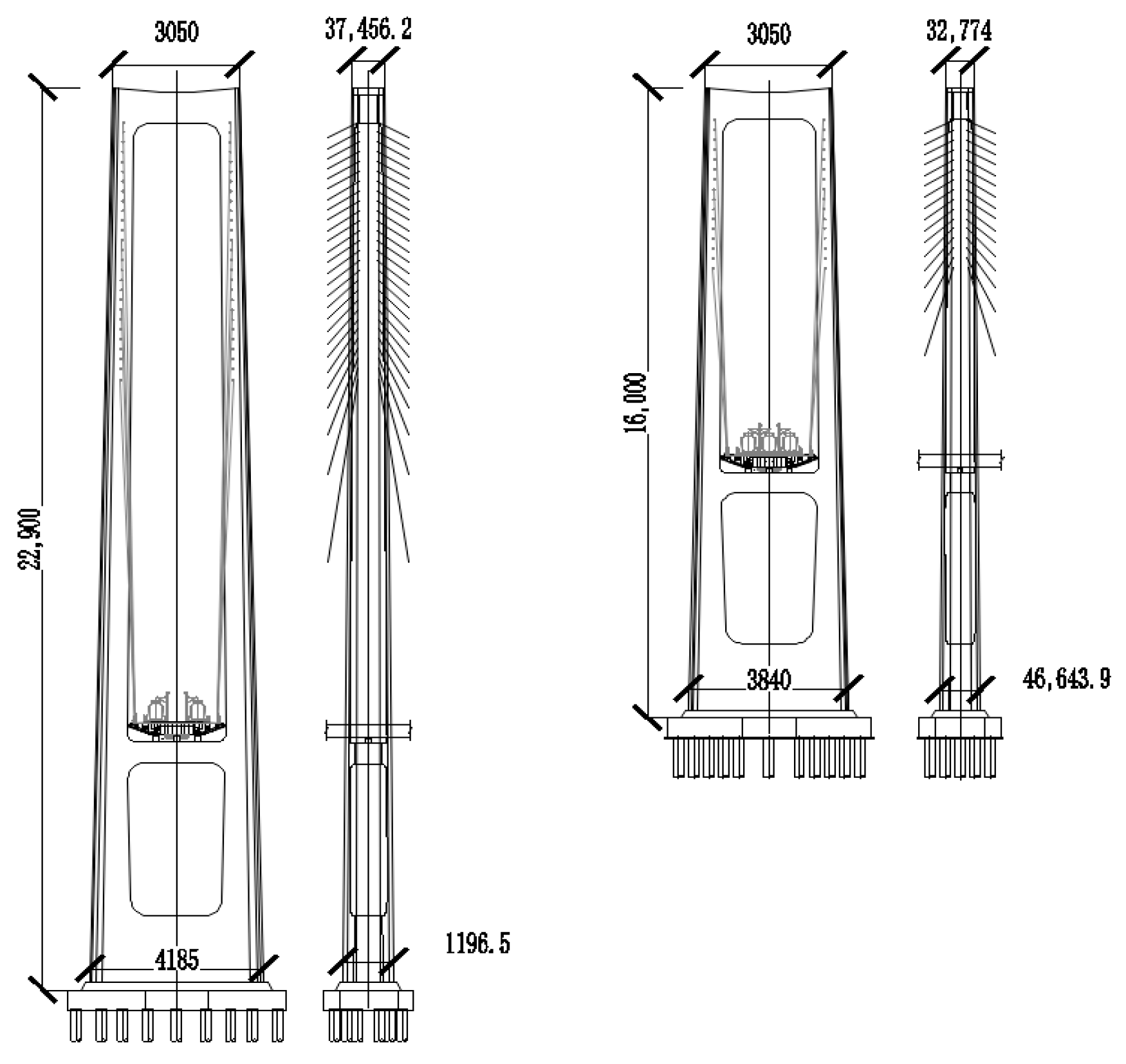


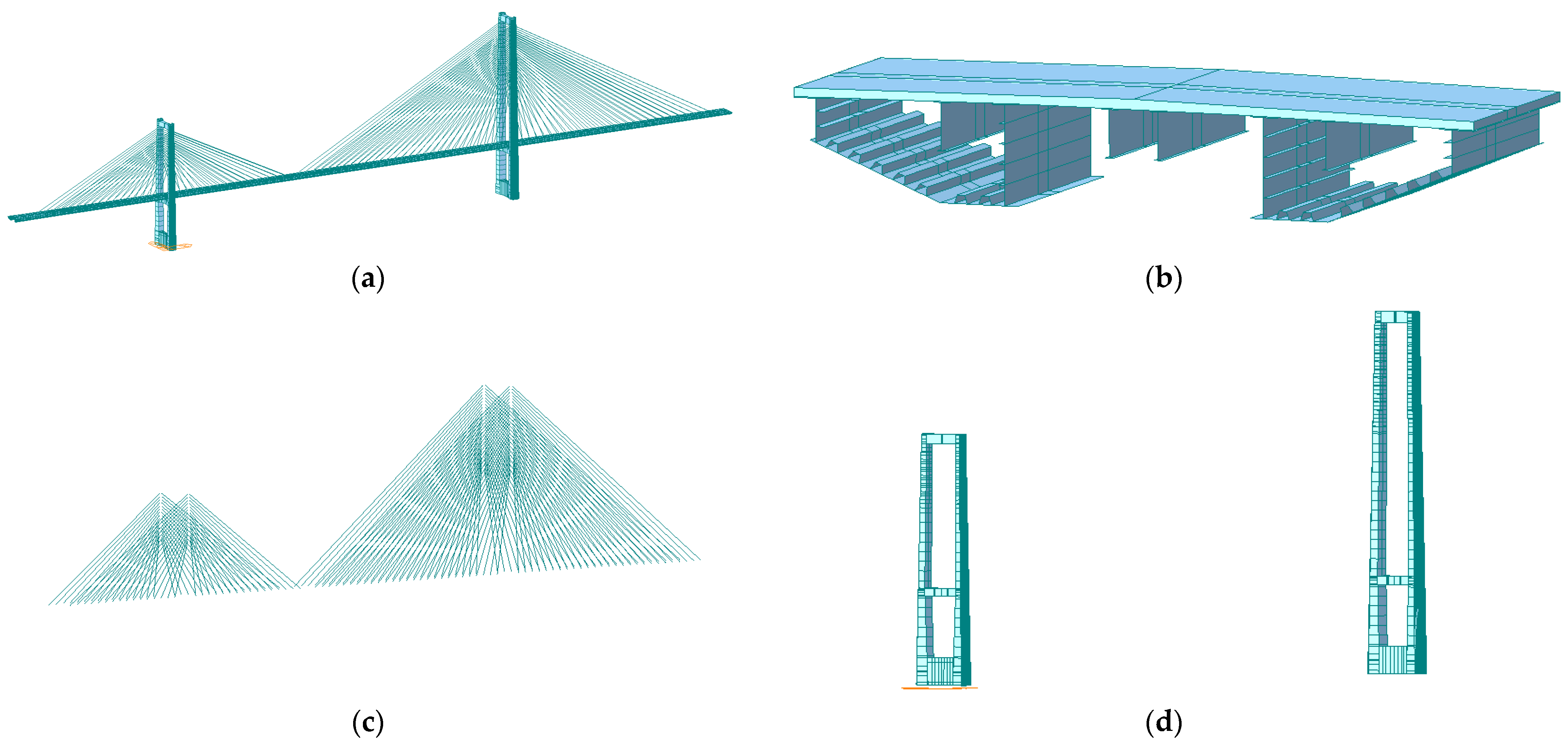
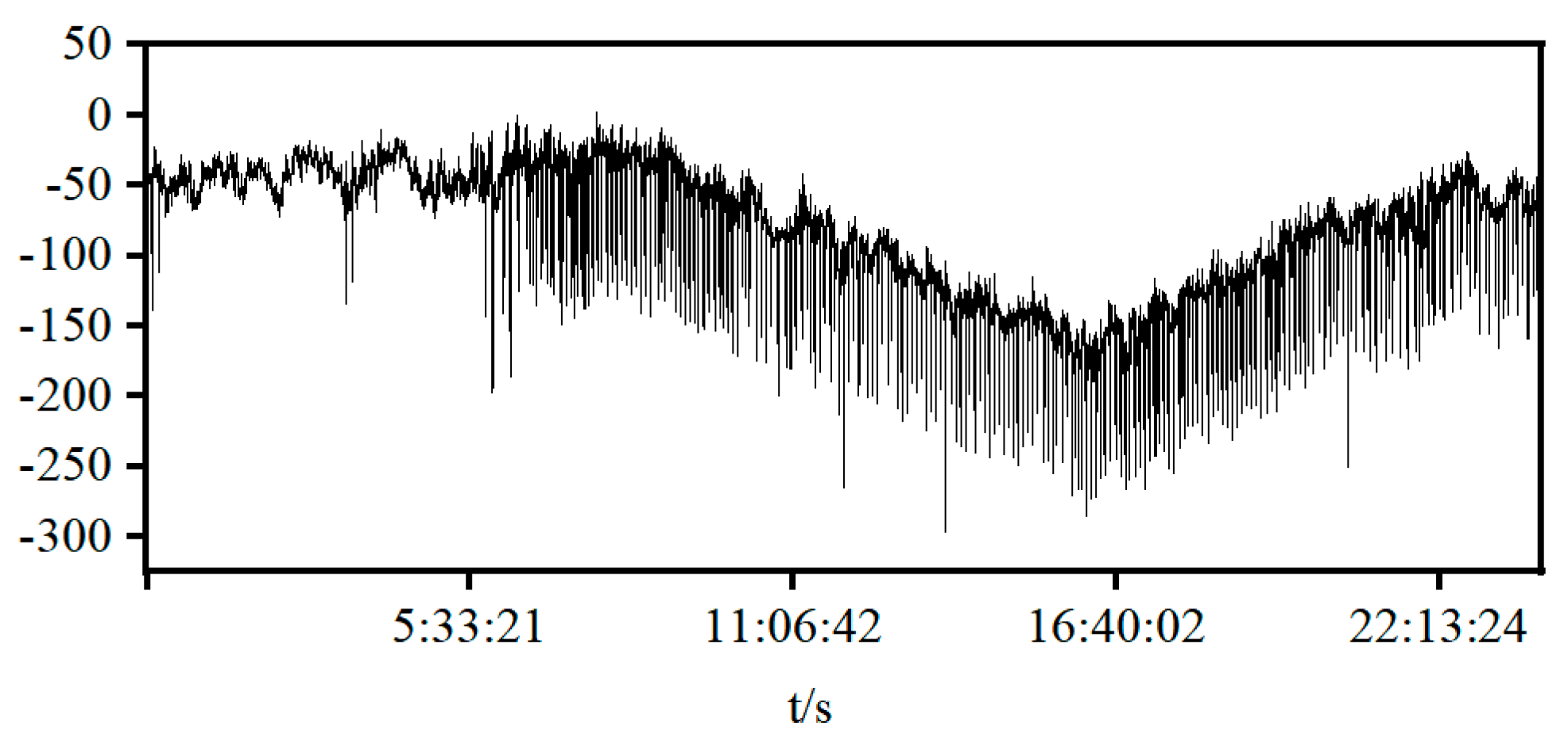


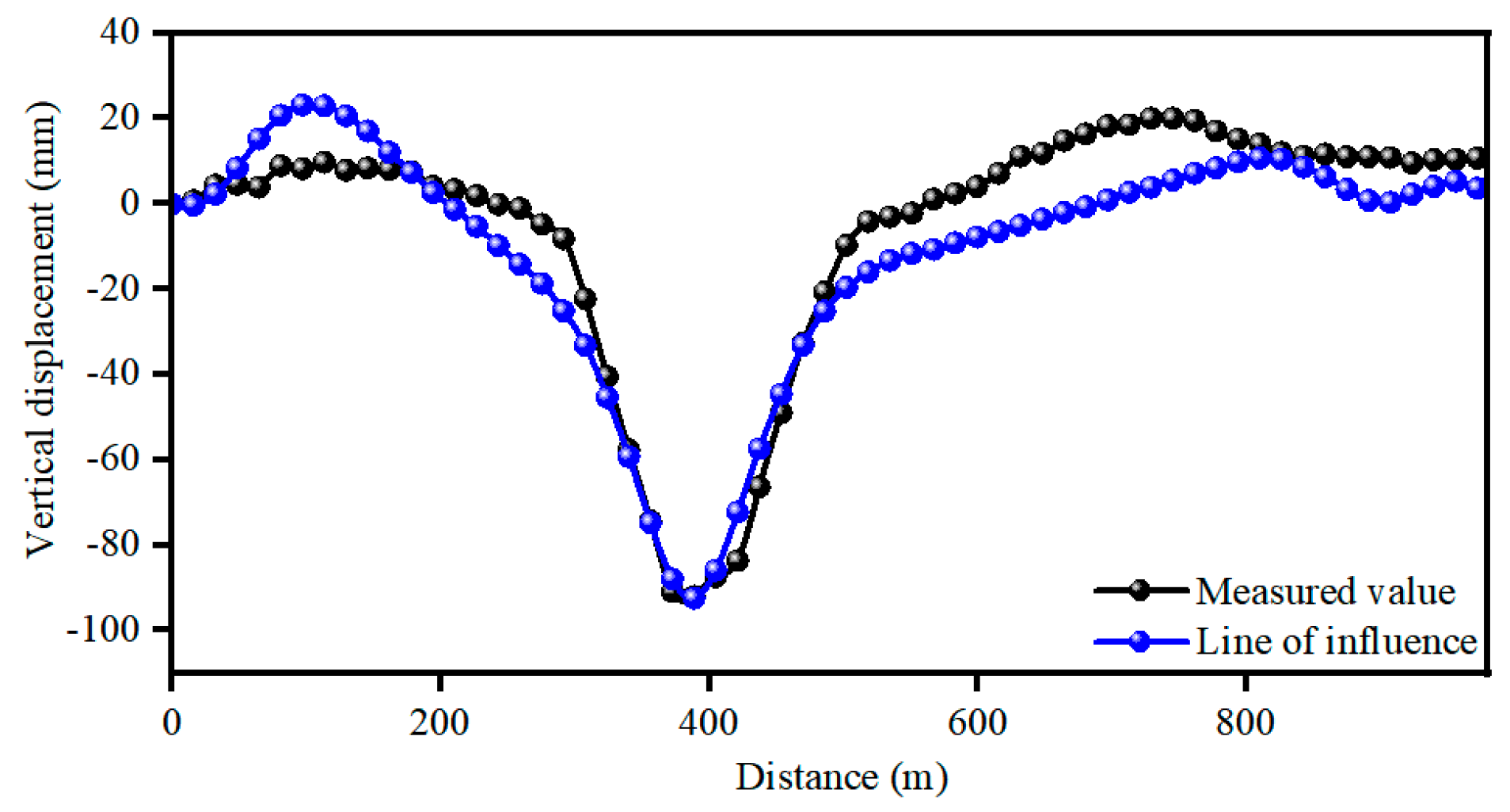

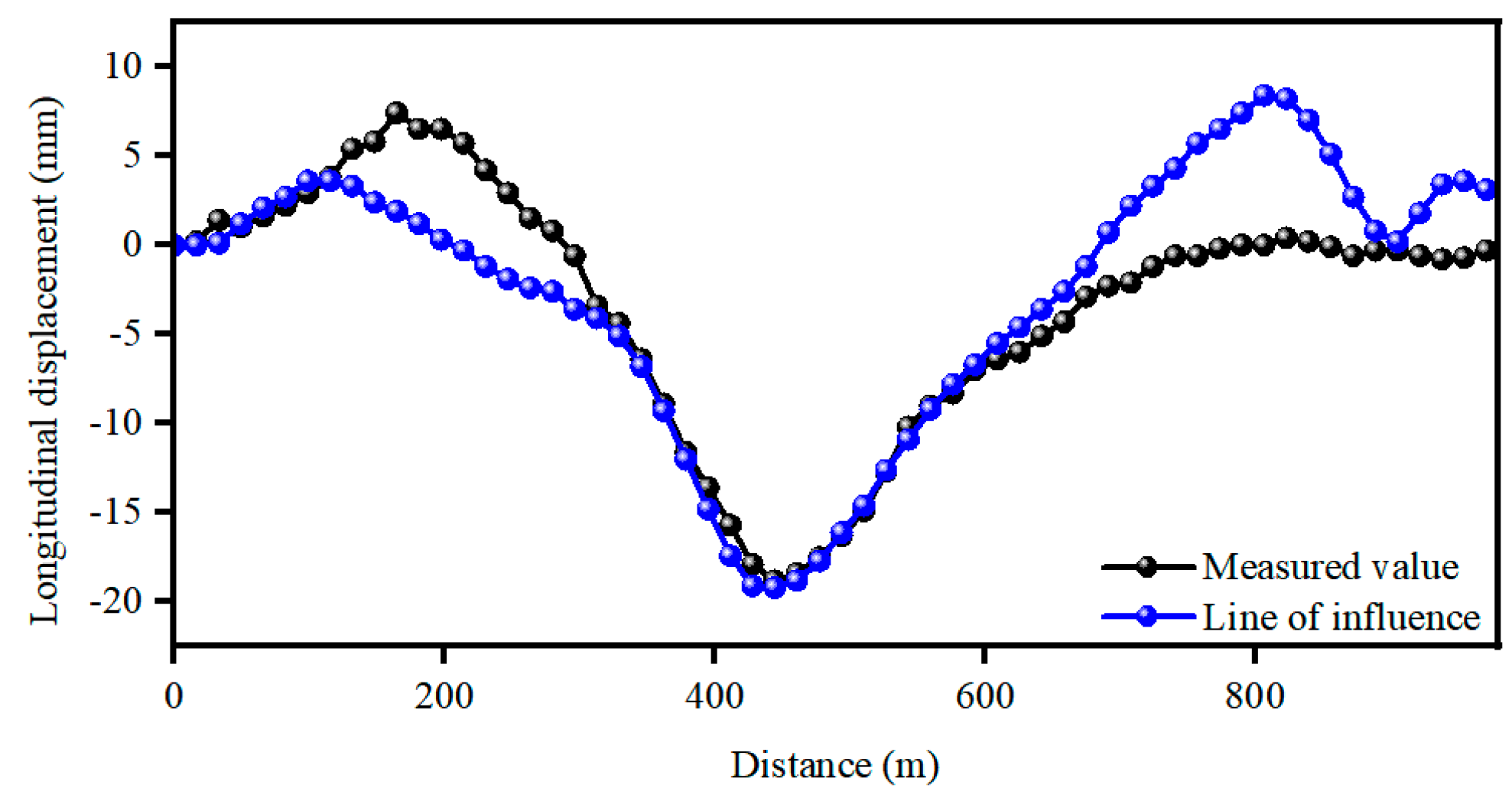
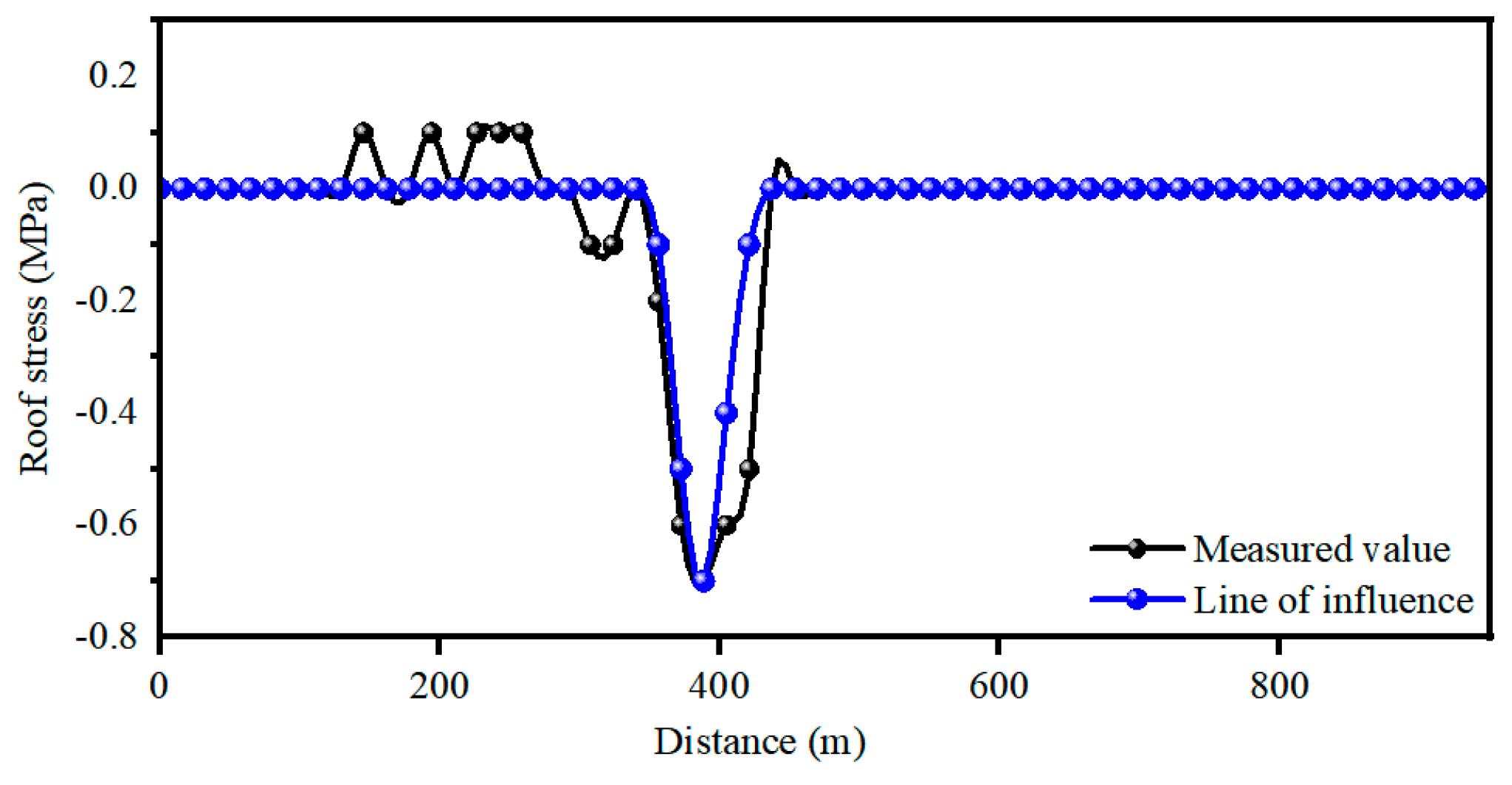
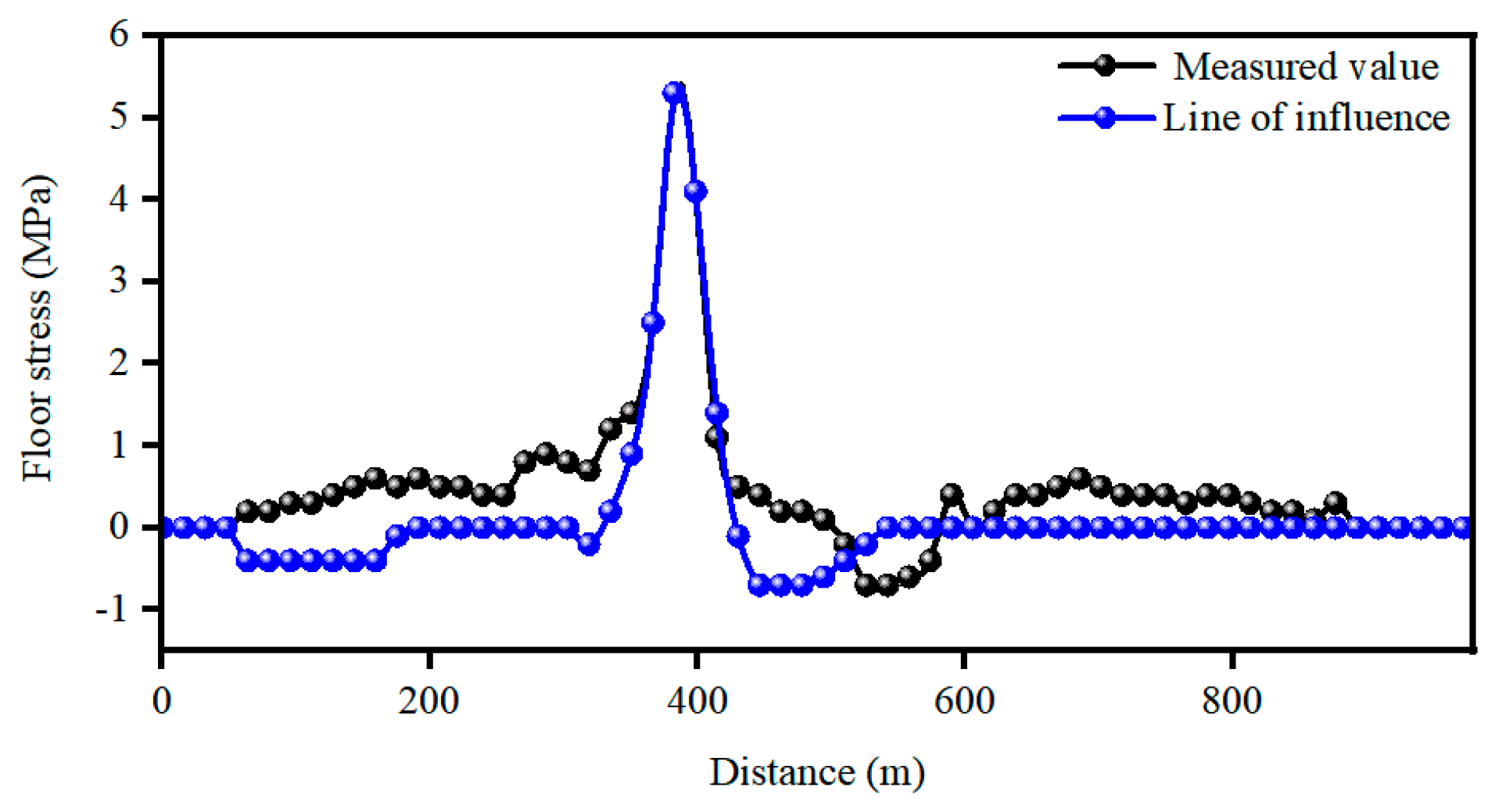

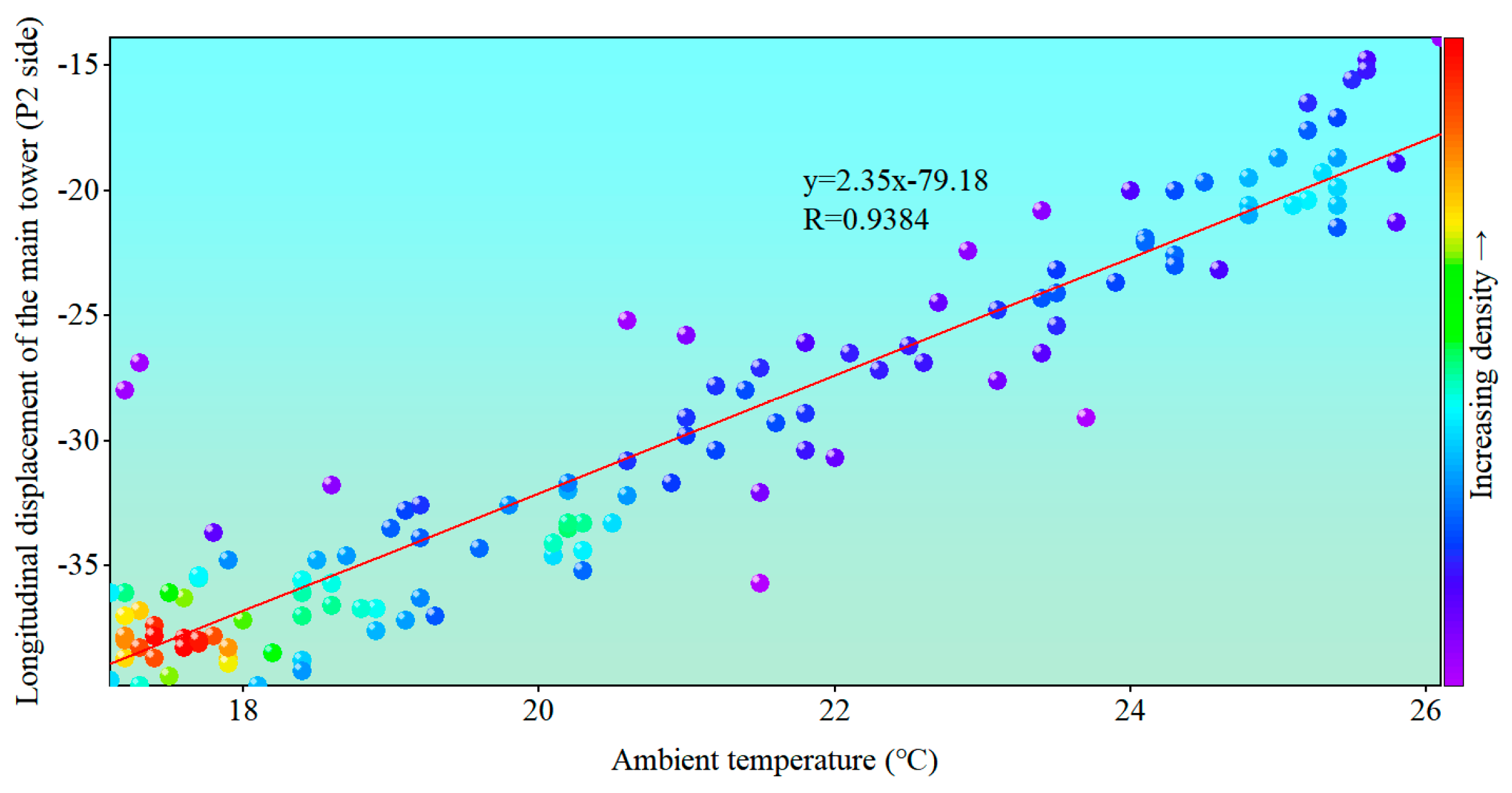
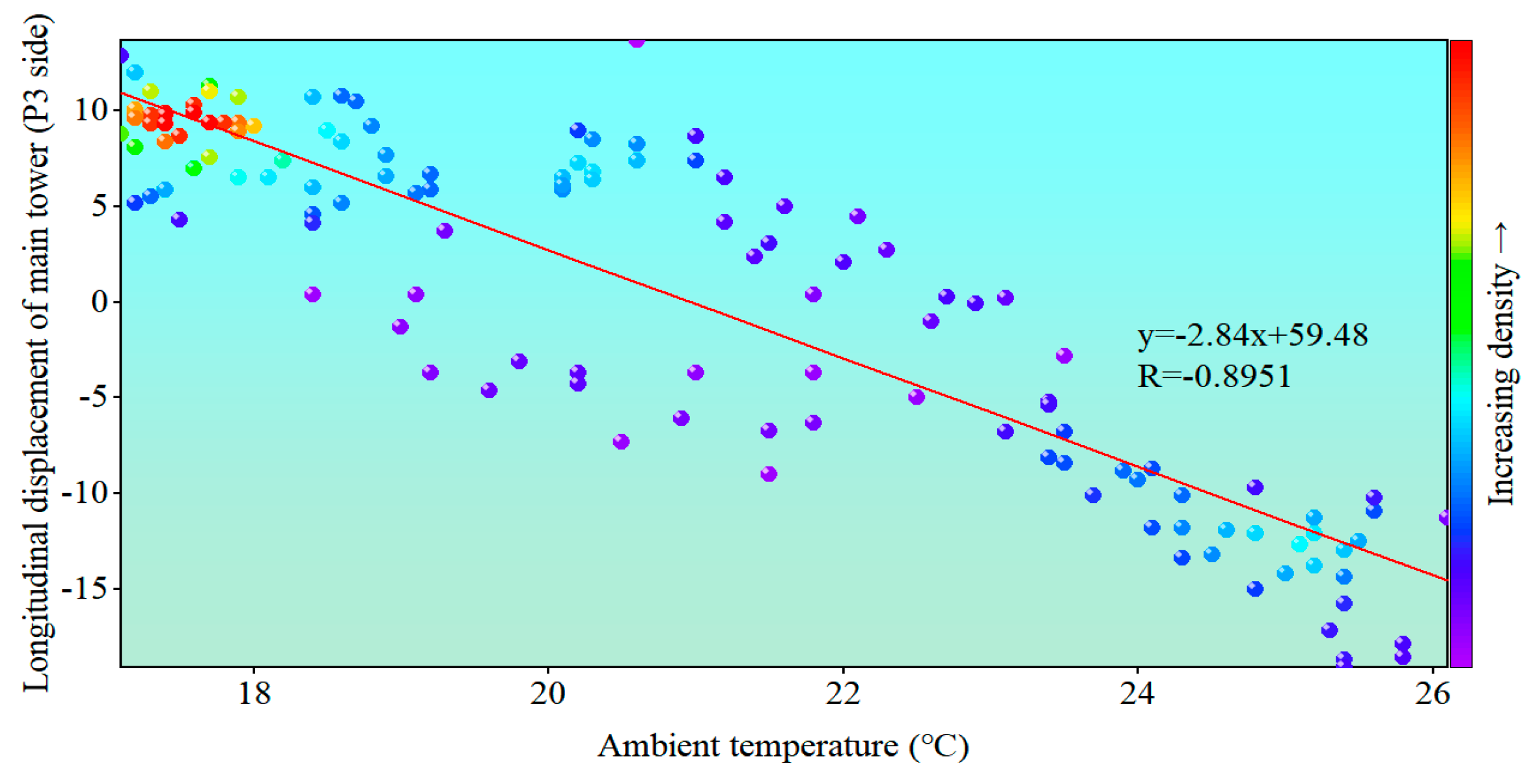
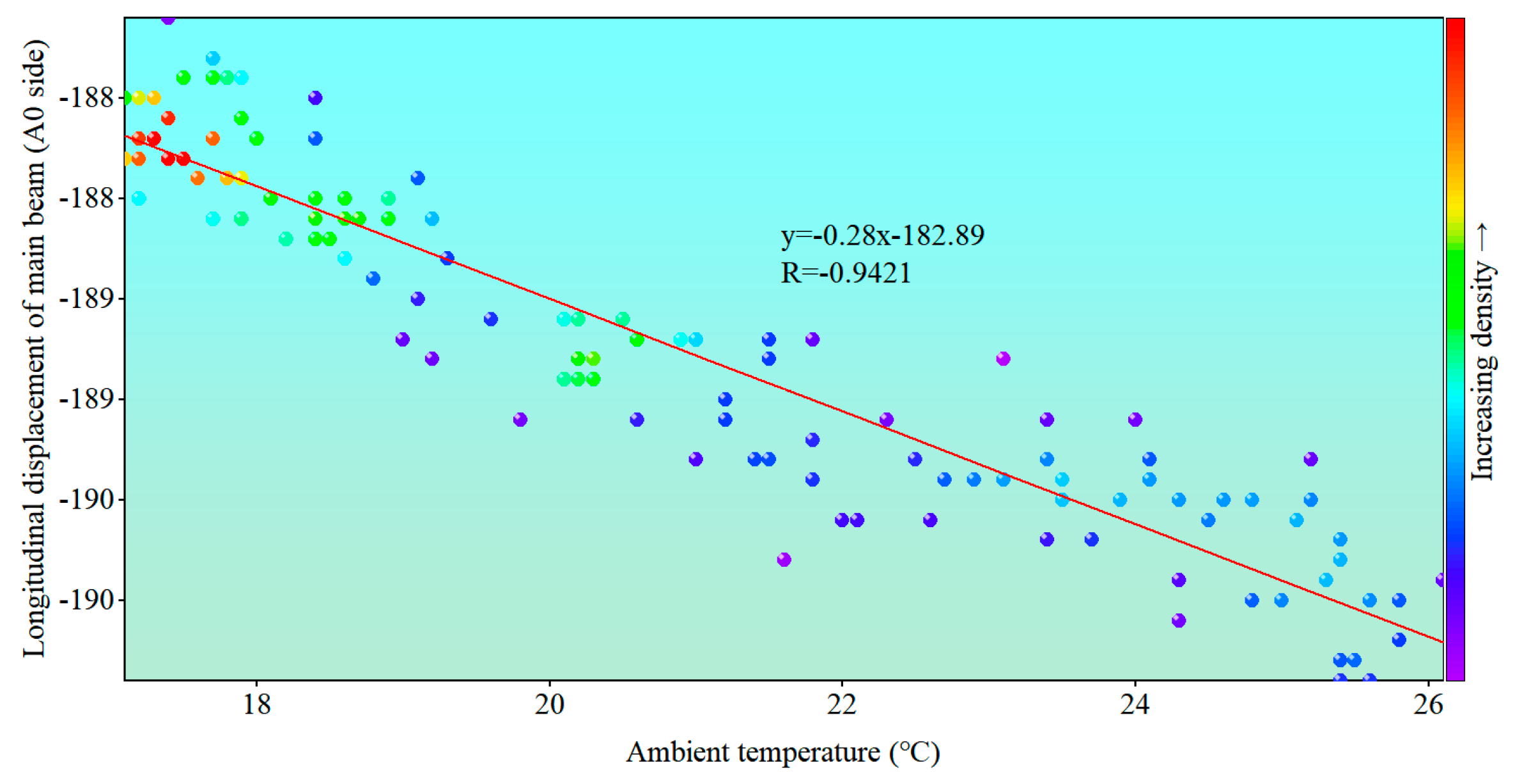
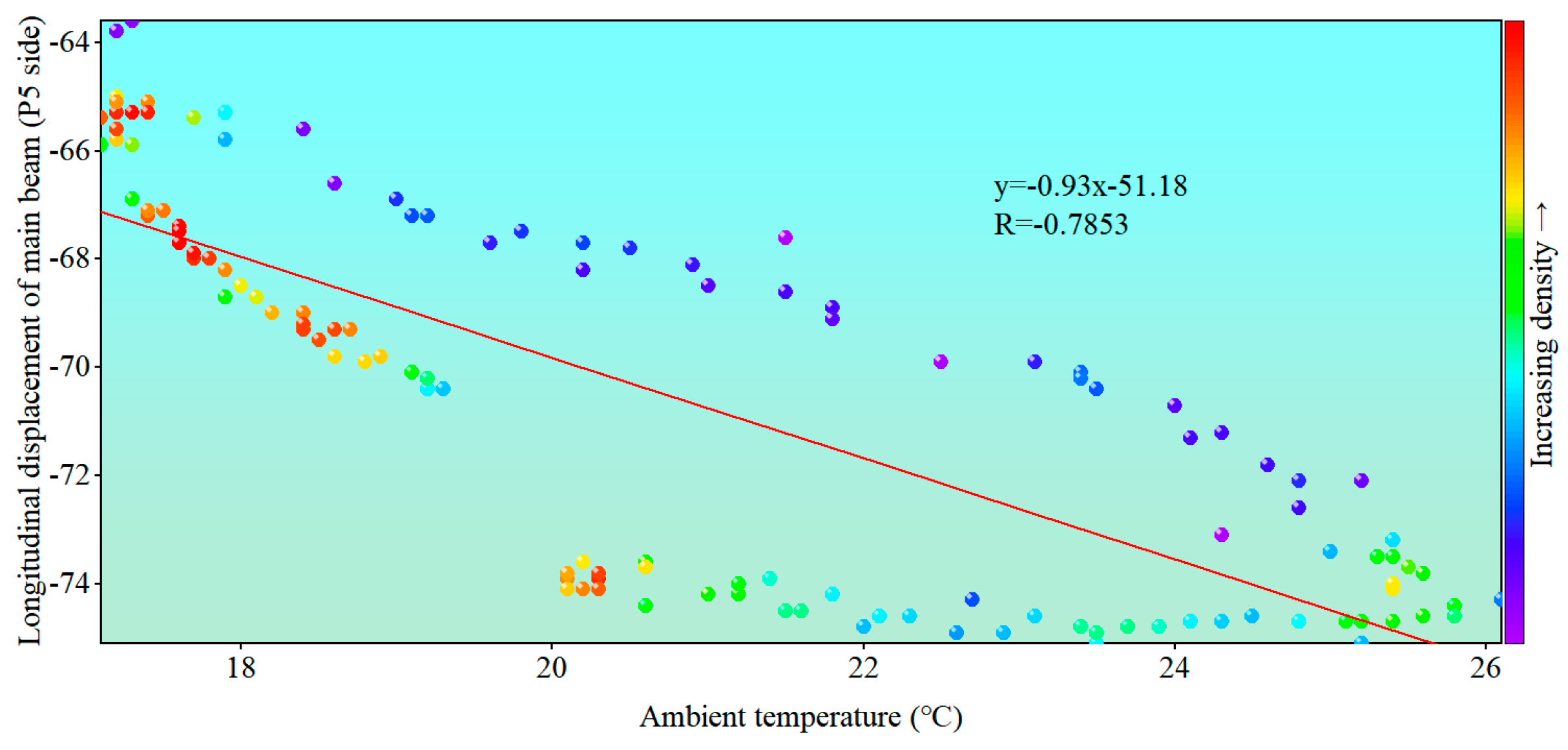
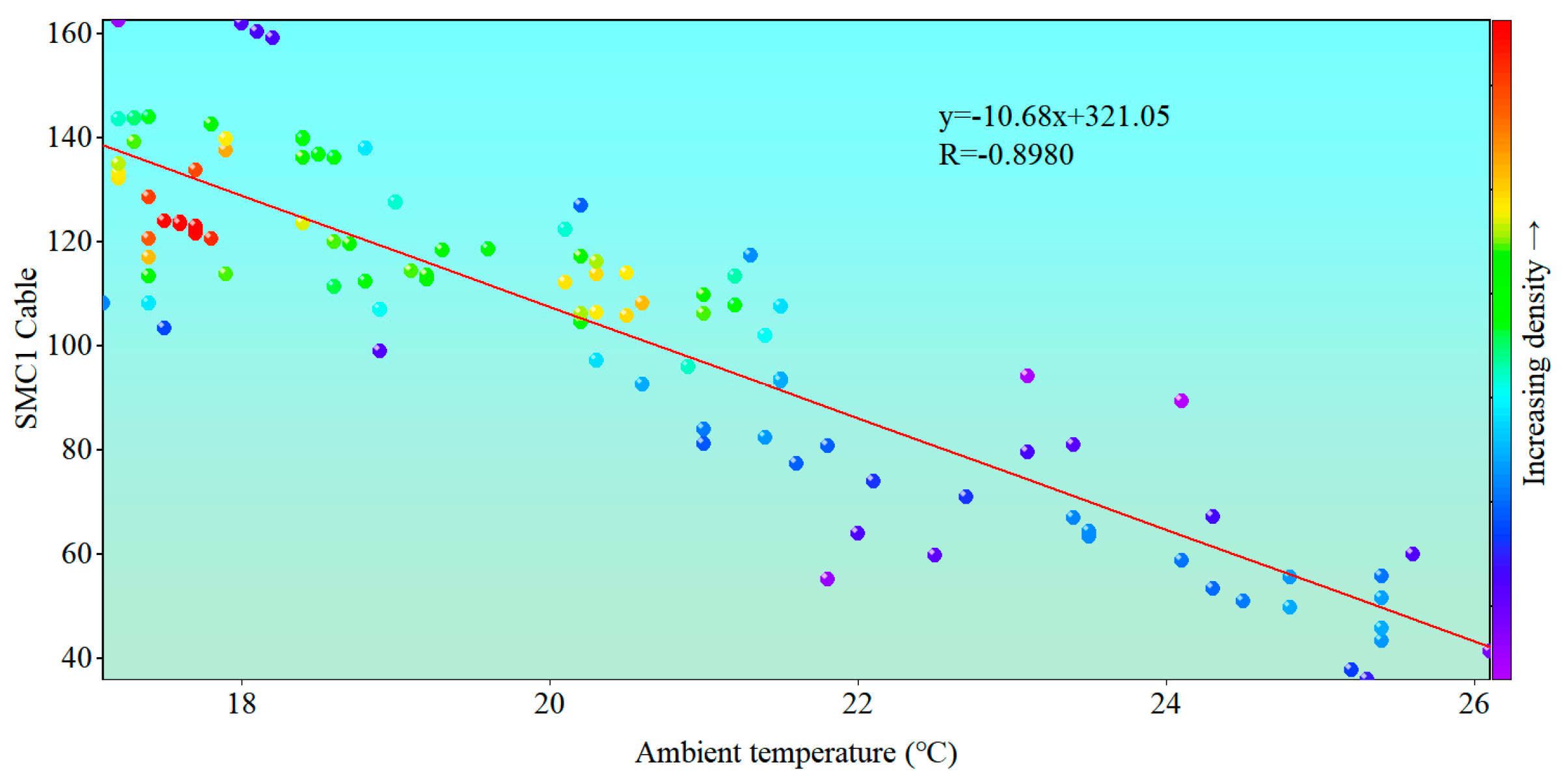
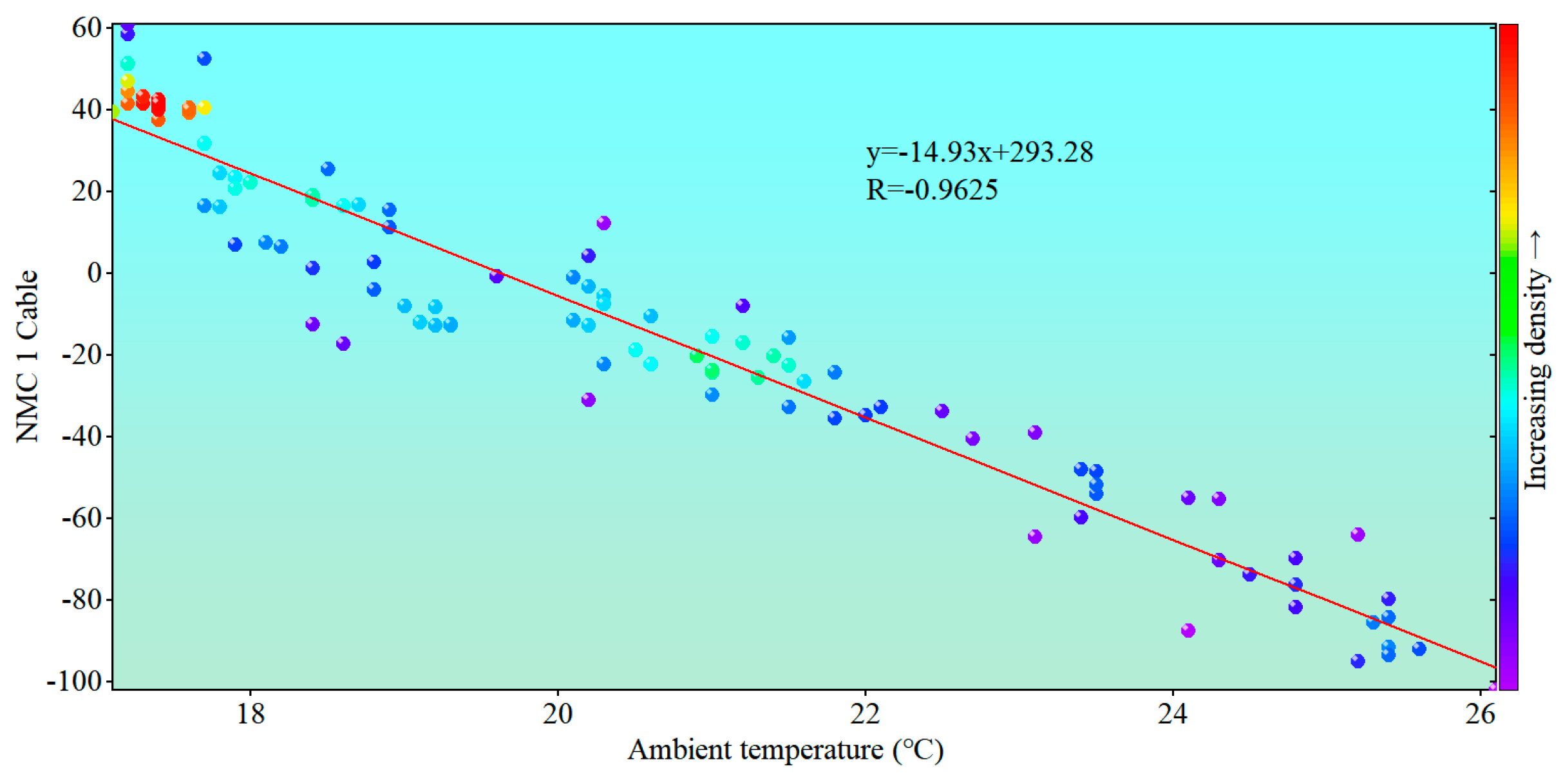
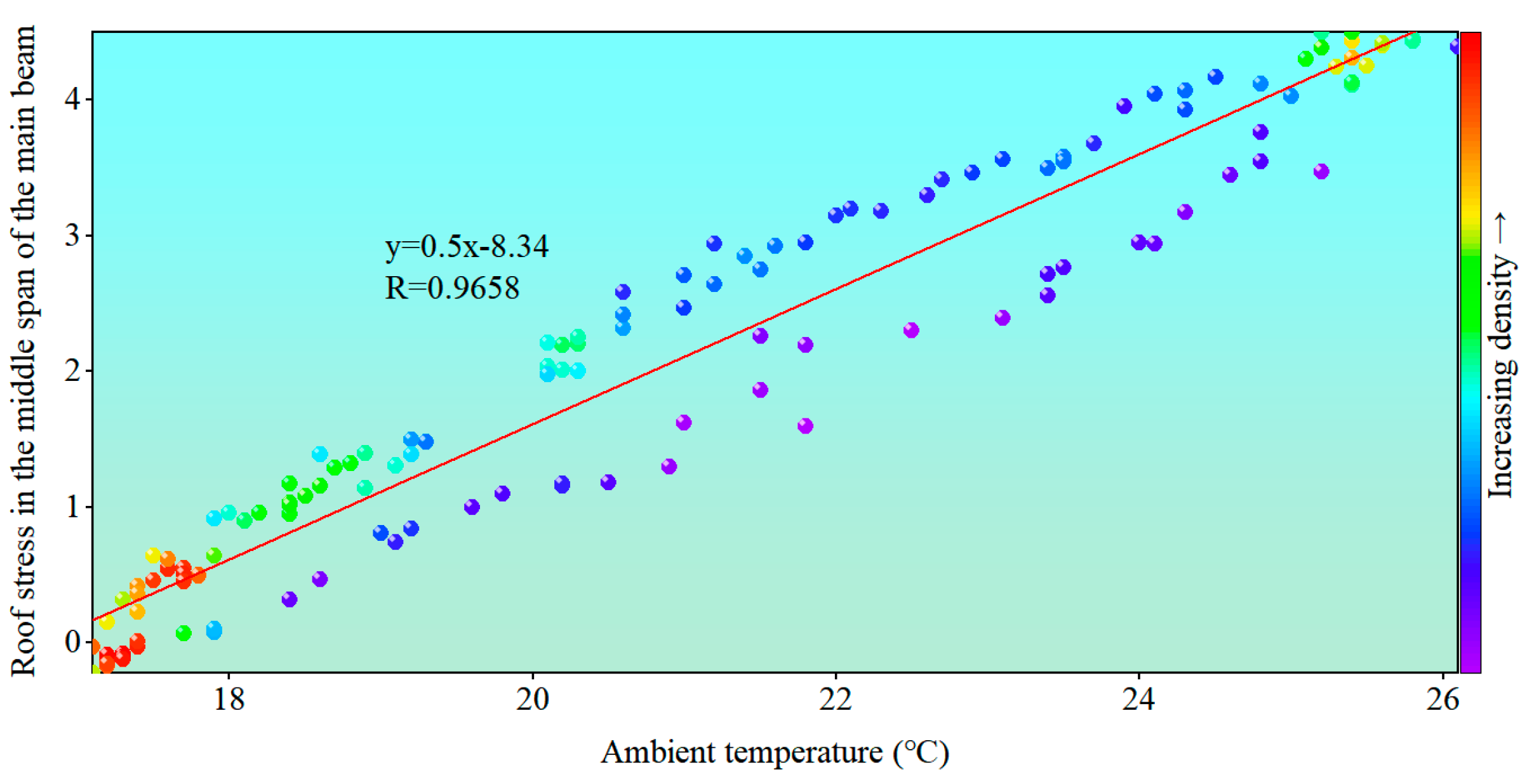
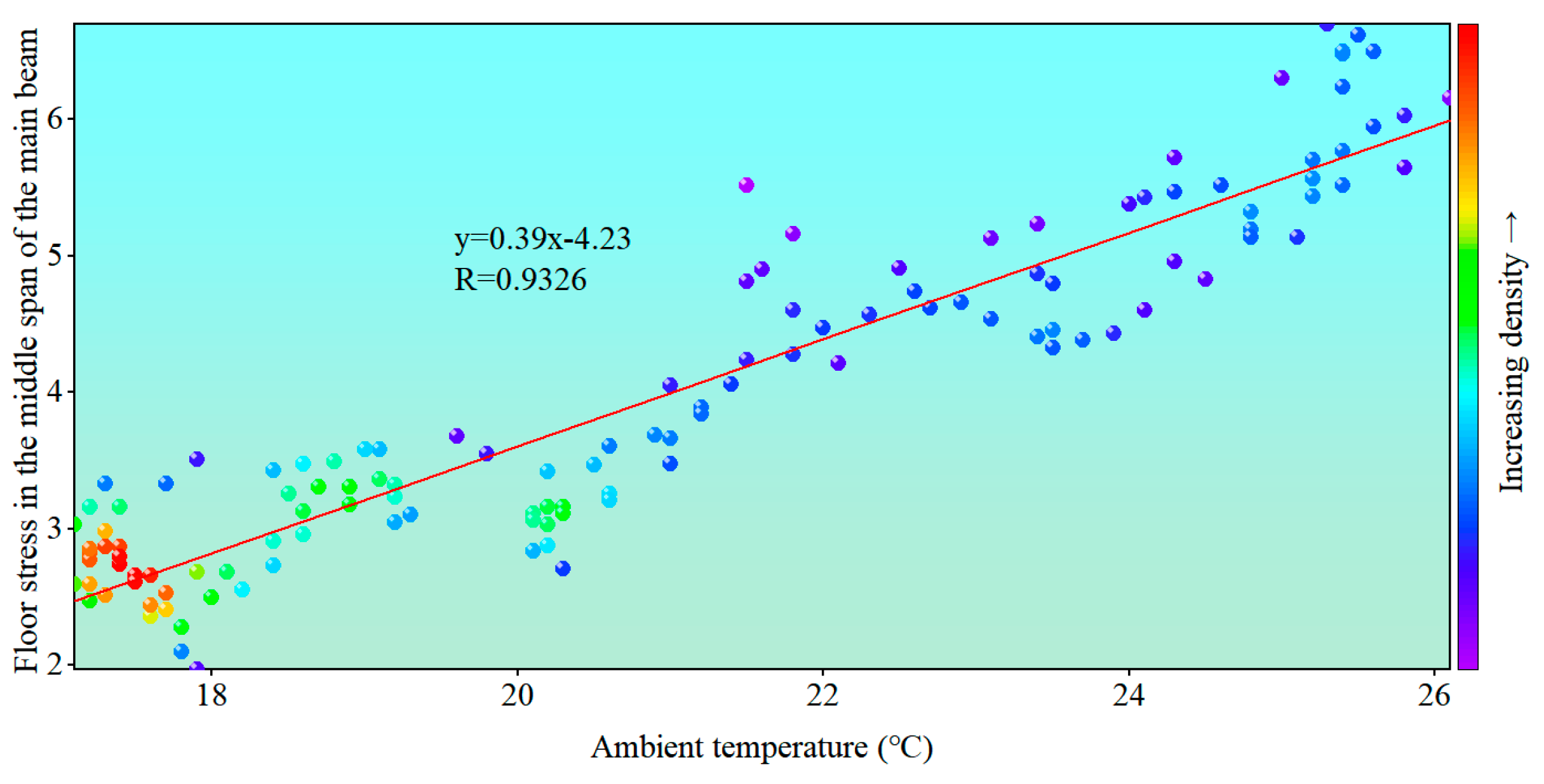
| Category | Monitoring Item | Number in Figure 5 * | Main Parameter | Device Type | Sampling Frequency |
|---|---|---|---|---|---|
| Load and environmental monitoring | Strike | ⑫, ⑬, ⑭ | Crash—Ship crash | Unidirectional acceleration sensor | 20 Hz |
| Temperature | ⑯, ㉓ | Temperature—Ambient temperature | Hygrograph | 1/600 Hz | |
| ⑥ | Temperature—Temperature inside the box girder | Hygrograph | 1/600 Hz | ||
| Humidness | ⑯, ㉓ | Humidity—Ambient humidity | Hygrograph | 1/600 Hz | |
| Humidity—Box girder inside wet | Hygrograph | 1/600 Hz | |||
| Rainfall | ⑲ | rainfall | Hyetometer | 1/60 Hz | |
| Water level | ⑰ | Water level | Radar water level gauge | 1 Hz | |
| Wind | ⑮ | Wind speed and direction | anemometer | 1 Hz | |
| Static and dynamic response monitoring of the whole structure | Vibration | ⑨, ⑩ | Vibration—Main beam vibration | Unidirectional acceleration sensor | 20 Hz |
| ⑳, ㉑ | Vibration—Tower vibration | Unidirectional acceleration sensor | 20 Hz | ||
| Amorphosis | ④ | Deformation—Vertical change in the main beam | Static level | 1 Hz | |
| ⑪ | Deformation—Tower space deformation (GNSS) | GNSS deformation monitoring system | 1 Hz | ||
| Static and dynamic response monitoring of the whole structure | Amorphosis | ⑪ | Deformation—Main beam space deformation (GNSS) | GNSS deformation monitoring system | 1 Hz |
| ⑧ | Deformation—Horizontal displacement of the pier | Inclinometer | 1 Hz | ||
| ① | Deformation—Displacement of expansion joint | Fiber grating displacement meter | 1 Hz | ||
| Corner | ② | Corner | inclinometer | 1 Hz | |
| Structure local response monitoring | Stress | ⑤ | Main beam stress | Fiber grating strain gauge | 1 Hz |
| ㉒ | Main tower stress | Fiber grating strain gauge | 1 Hz | ||
| Cable force | ⑱ | Cable force of the cable | Cable force accelerometer | 20 Hz | |
| Transcore pressure sensor | 1/60 Hz | ||||
| Structural fatigue | ⑦ | Fatigue of steel structure | Fiber grating strain gauge | 1 Hz |
| Serial Number | Structural Response Parameter | NCC | Similarity |
|---|---|---|---|
| 1 | Vertical displacement of the main beam | 0.9457 | High |
| 2 | Longitudinal displacement of the main tower (P2 side) | 0.9531 | High |
| 3 | Longitudinal displacement of the main tower (P3 side) | 0.8873 | High |
| 4 | Roof stress in the span of the main beam | 0.9098 | High |
| 5 | Middle floor stress of main beam span | 0.9101 | High |
| Serial Number | Structural Response Parameter | Pearson Correlation Coefficient R | Strength of Correlation |
|---|---|---|---|
| 1 | Vertical displacement of the main beam | −0.9634 | strong |
| 2 | Longitudinal displacement of the main tower (P2 side) | 0.9384 | strong |
| 3 | Longitudinal displacement of the main tower (P3 side) | −0.8951 | strong |
| 4 | Longitudinal displacement of the main beam (A0 side) | −0.9421 | strong |
| 5 | Longitudinal displacement of the main beam (P5 side) | −0.7853 | strong |
| 6 | SMC1 Cable | −0.8980 | strong |
| 7 | NMC1 Cable | −0.9625 | strong |
| 8 | Roof stress in the span of the main beam | 0.9658 | strong |
| 9 | Middle floor stress of main beam span | 0.9326 | strong |
Disclaimer/Publisher’s Note: The statements, opinions and data contained in all publications are solely those of the individual author(s) and contributor(s) and not of MDPI and/or the editor(s). MDPI and/or the editor(s) disclaim responsibility for any injury to people or property resulting from any ideas, methods, instructions or products referred to in the content. |
© 2024 by the authors. Licensee MDPI, Basel, Switzerland. This article is an open access article distributed under the terms and conditions of the Creative Commons Attribution (CC BY) license (https://creativecommons.org/licenses/by/4.0/).
Share and Cite
Ding, P.; Li, X.; Chen, S.; Huang, X.; Chen, X.; Qi, Y. Load Effect Analysis Method of Cable-Stayed Bridge for Long-Span Track Based on Adaptive Filtering Method. Appl. Sci. 2024, 14, 7057. https://doi.org/10.3390/app14167057
Ding P, Li X, Chen S, Huang X, Chen X, Qi Y. Load Effect Analysis Method of Cable-Stayed Bridge for Long-Span Track Based on Adaptive Filtering Method. Applied Sciences. 2024; 14(16):7057. https://doi.org/10.3390/app14167057
Chicago/Turabian StyleDing, Peng, Xiaogang Li, Sheng Chen, Xiangsheng Huang, Xiaohu Chen, and Yong Qi. 2024. "Load Effect Analysis Method of Cable-Stayed Bridge for Long-Span Track Based on Adaptive Filtering Method" Applied Sciences 14, no. 16: 7057. https://doi.org/10.3390/app14167057




